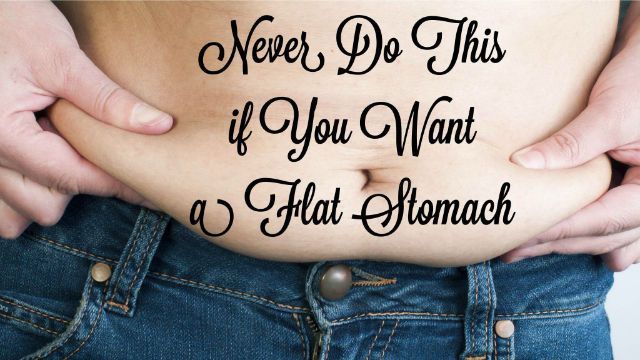
With bathing suit season upon us, you may be dreading the upcoming pool party or trip to the beach. Perhaps your winter hibernation has left you a few pounds heavier – especially around your midsection.
If you are like many people, you tend to accumulate extra fat around your belly. Not only is abdominal fat, also called visceral fat or ‘belly fat,’ unsightly, it can lead to an increased risk of a number of health conditions.
Some of the risks associated with carrying excess fat around your middle are a greater susceptibility to type 2 diabetes and heart disease. Additionally, as this fat tends to coat vital organs, it can cause system-wide inflammation that can trigger an array of other chronic illnesses.
So, what can be done with this flat stomach-busting fat? Should you cut back on calories, eliminate fat, cut out all carbs and exercise more? While there are still a mixture of theories out there as to the exact best way to reduce stubborn belly fat, there does seem to be more of a meeting of the minds, so to speak, when it comes to understanding this dilemma.
Of course, exercise is paramount to a healthy lifestyle; we must move every day – but let’s take a look at something else that is absolutely essential – food. Food has the innate power to either destroy or renew health.
Food is equally as powerful as any drug that you will put into your body. With the right food, your body is capable of doing amazing things – like healing, migrating to a healthy weight and allowing you to live a long and productive life.
Two familiar foods, which you may have thought were relatively healthy, are now being uncovered as heavy players in the current obesity epidemic. All advertising slogans and lures aside, these two foods can be downright dangerous to health when consumed on their own, and a double whammy when eaten together.
Although, every morning across America, millions of kids and adults sit down to a breakfast containing these two foods: whole wheat bread and commercial breakfast cereals.
Whole wheat bread
Whole wheat bread is extremely high in sugar. In fact, some bread is higher in sugar than soda or candy bars. Two slices of whole wheat bread can raise blood sugar higher than 6 teaspoons of table sugar. How does this happen when whole wheat is considered a complex carbohydrate that we are encouraged to eat more of?
The complex carbohydrate found in wheat is called Amylopectin A, which is highly sensitive to amylase, which we have in our stomach and mouth. This makes it very easy to digest, and it therefore raises blood sugar rapidly. Wheat for breakfast, wheat for lunch and wheat for snacks results in visceral fat that encircles the intestines, heart, liver and kidneys. Repetitive high blood sugar results in what Dr. William Davis, author and physician, calls a “wheat belly.”
According to Dr. Davis, wheat is a “perfect chronic poison.” Last September, he told CBS This Morning that modern wheat is an “18-inch tall plant that was created by genetic research in the 1960s and ‘70s,” noting that it has many new features, including a new protein known as gliadin.
Davis says: “It’s not gluten. I’m not addressing people with gluten sensitivities and celiac disease. I’m talking about everybody else because everybody else is susceptible to the gliadin protein that is an opiate. This thing binds into the opiate receptors in your brain and in most people stimulates appetite, such that we consume 440 more calories per day, 365 days per year.”
Commercial breakfast cereals
Cereal is, by and large, one of the worst foods for your waistline, and your health. Perhaps what is most disturbing about so many brands of cereal is that they confuse the heck out of consumers by making them sound so healthy and nutritious, when in reality they are anything but.
For example, while at the grocery store you may find a “Yogurt Berry Crunch” cereal (with added fiber!) from a popular brand. It sure sounds healthy…
In fact, the label even makes claims like “heart healthy!” and points out that it contains “25 grams of whole grains.” “Rich in antioxidants, vitamin C & E,” too. Just add up all those health benefits!
But here’s the truth:
This so-called “healthy” cereal contains FIFTY ONE ingredients, including not one, not two, not six, not seven, but TEN different sources of SUGAR.
Paul van der Velpen, the head of Amsterdam’s health service, recently said in an online post: “This may seem exaggerated and far-fetched, but sugar is the most dangerous drug of the times.”
Van der Velpen points to sugar’s addictive effect on the appetite as the reason for this claim: “Sugar upsets that mechanism. Whoever uses sugar wants more and more, even when they are no longer hungry. Give someone eggs and he’ll stop eating at any given time. Give him cookies and he eats on even though his stomach is painful.”
The more sugar we consume the faster our waistline expands, and the more we want it.
The above-mentioned cereal also contains SEVEN corn derived ingredients (very likely from genetically modified corn), including corn syrup and corn starch.
It’s also loaded with inflammatory wheat ingredients, not to mention two of the worst damaged, denatured oils you can consume… canola oil and soybean oil.
 Combine the two…
Combine the two…
As you can see, whole wheat toast and most breakfast cereals alone spell disaster for your health, but putting them together can keep you from ever banishing your belly fat and promote other damaging lifestyle illnesses.
Buttery spread makes matters worse
What you put on your toast can add insult to injury. Do you use a processed fake butter spread which most likely contains hydrogenated or partially hydrogenated oil -better known as trans fat?
Trans fatty acids, one of the more common demons in our diet, have been named “phantom fats” because the FDA did not require them to be listed on food labels until 2006 – seven years after the initiative was proposed.
Even now, up to 0.5 grams can be found in foods that are labelled “zero trans fats.” This dangerous substance allows foods to last longer without spoiling, lowers food production costs and gives food a better taste, according to food manufacturers.
Artery-clogging trans fats have been linked to between 30,000 to 100,000 premature heart failures per year in our country alone.
Many so called “healthy” foods actually contain trans fat but consumers think differently. Reading the label is imperative if you really want to know whether or not food contains this deadly ingredient. If you see the words “partially hydrogenated” anywhere on the label, put the item back on the shelf, don’t waste your money.
What about jelly?
Every day, millions of Americans enjoy the sweet taste and unique texture of jams and jellies. These popular spreads have been a household staple in our country, and many others, for a very long time.
Jams and jellies both contain pectin and sugar. In fact, the British, famous for their delectable jams, have an industry standard of 60 percent added sugar. If jam does not contain this much sugar, it can’t be called a jam in England.
A closer look at American favorites doesn’t bring good news either. A quick glance at the back of a Smucker’s Concord Grape Jelly jar reveals the sordid truth:
Ingredients:
Concord grape juice, high fructose corn syrup, corn syrup, fruit pectin, citric acid, sodium citrate
The grape juice itself has a high amount of natural sugar, and with the second ingredient being high fructose corn syrup, there is cause to be concerned. There are 12 grams of sugar per tablespoon.
The main problem with this jelly is that the sugar is not natural, but added in one of the most dangerous forms of all: high fructose corn syrup.
High fructose corn syrup is a type of sugar found in many processed foods, with a higher fructose to glucose ratio than regular sugar. It can be even more dangerous for the body than sugar, because the excess fructose content is absorbed directly by the liver. This can lead to weight gain, inflammation, fatty liver, a dramatic spike in blood sugar and an elevated risk of type 2 diabetes.
In fact, it is thought by many experts that high fructose corn syrup is the driving force behind America’s obesity epidemic. It slows down the body’s secretion of leptin, the hormone which signals to your brain that you are full. This leads to cravings for more and more high fructose corn syrup.
The healthiest breakfast combinations
If you are ready to give up your morning toast and cereal, here are just a few tasty combinations you can try instead. Chances are you will start to look and feel better in no time having eliminated them from your diet.
- Scrambled eggs made from free range eggs and a bowl of fresh fruit
- Oatmeal and blueberries with organic milk
- Grass fed steak, scrambled eggs and cantaloupe
- Organic Greek yogurt, local honey and fresh fruit topped with chia seeds
Chocolate Blueberry Smoothie
This one really packs a nutritious punch, with lots of antioxidants along with a special deliciousness no kid, or adult, can resist!
Blend together 2 leaves lacinato kale; ¼ cup frozen blueberries; 2 tablespoons cacao powder; 1 banana; 1 to 2 pitted medjool dates and 1 cup hemp or almond milk.
Combine eating healthy whole foods with regular exercise and you will soon be ready for the beach.
-The Alternative Daily

